Mike Perschon's Blog
June 15, 2024
Let’s Try This Again, Shall We? (A Soft Reboot)
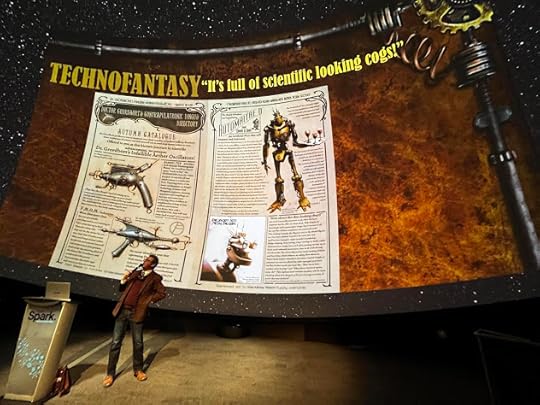
It’s wild to me to think that it’s been over 15 years sinceI started this blog. It feels weird just writing the word ‘blog.’ Who blogsanymore? Everyone who writes is on Substack or Ghost these days. Fifteen yearsago, my kids were tiny, now they’re grown. Back then, my hair was brown; nowit’s going grey and there’s less of it. In 2008, I was starting my PhD; now I’man Associate Professor at MacEwan University. Back then, I was learning whatsteampunk was; now I’m an “expert” who’s written a bunch of articles and a bookon the subject.
It's also wild to me that it’s been about five years since Iposted here, in January of 2019. I was all set to start posting about steampunkagain, and then got an offer to submit an academic article to a special journalissue focused on Neo-Victorianism and steampunk. That wound up becoming aproject I completed with two of my brightest students, and while the journey tocompletion was one of the worst editorial experiences I’ve ever had (with thepeople who ran the journal, not the guest editors of that issue), the finishedproduct was worth the trip.
By the time that was wrapping up, the world was headed intothe pandemic. I spent the next three years learning how to teach all overagain. I posted my lectures as videos on YouTube and the audio on a podcastcalled Triple Bladed Sword. At the tail end of lockdown, I taught acourse on steampunk for the first time. Someone might question why it’s takenme so long to teach a course solely on steampunk: I simply never wanted to beone of those profs who inflict their PhD on their students. And while the coursewas a delightful experience with a wonderful group of students, I don’t know ifI’ll ever do it again. It’s weird to teach content that keepsreferencing me. I mean, that was the goal back in 2008 – to research somethingnew and become one of the voices future steampunk scholars would reference. Allthat said, you can check out the video lectures from that course here.
When lockdown ended for good in the fall of 2022, I wasteaching new courses and working on another academic publication on steampunk(the editorial process was lovely this time around). The book was just releasedby Brill, and I’m really excited about it. I wrote my chapter about the bookand film Mortal Engines; it’s also an updated version of my SteamWars article from back in 2010.
Last fall, my first academic article on steampunk, “FindingNemo: Verne’s Antihero as Original Steampunk” got a reissue in print in GaryWestfahl’s Jules Verne Lives: Essays on His Works and Legacy. It was anhonour to be included in that book, given that Westfahl was one of the firstacademics I used in my steampunk research. The book was also a tribute to theEaton Conference, which was the first academic conference I presented any workon steampunk at. Consequently, that publication had me thinking back over mywork as “The Steampunk Scholar” and reflecting on how fortunate I’ve been in mycareer.
And just when I was convinced I should probably cull mysteampunk shelves and get on with some new avenues of research, I received aseries of invitations that made me wonder if the steampunk boiler is gettingfired up again. The first was for an interview on NPR radio in Connecticut onthe show Where We Live. The second was to teach a University stylecourse to seniors here in Edmonton (which was sadly canceled due to lowenrollment). The third was to give a talk on steampunk at an event at the TelusSpark Science Center in Calgary. This morning, I was in a Zoom meet with a bunch of steampunk luminaries talking about the state of the aesthetic. I haven’t been thinking and presenting about steampunkthis frequently since 2014.
And while all of that’s happening to me, I’m seeing friendsfrom the steampunk scene at conventions in the States. Critical Role is doing CandelaObscura, a campaign that has serious steampunk vibes. Netflix had a hitwith Arcana, which was unabashedly referred to as steampunk. Imagecomics had two big hits with steampunk properties: Bitter Root, set inthe Jazz era in the US, and Monstress, set in a secondary world of AsianArt Deco steampunk. What gives? Is this the swell of the third wave ofsteampunk? A steampunk scholar can only hope.
Regardless, it’s been too long since I ‘ve attended to this dusty old virtual space, and high time to start writing again. While I love a good academic publication, there’s nothing like writing here, in the freedom of my own editorial lethargy or vigour. If nothing else, I’d like to redress some of the sloppy work I did at the outset of this project when I was still figuring out what the hell academics do and how academics write. After fifteen years, I know what I do and how I write, and I’d like to revisit some of the books I wrote about way back when (particularly Westerfeld’s Leviathan, as I was playing the pretentious “associate the argument with an ‘important’ work of literature’ game, and consequently failed to write about the book at hand). There are just so many wonderful works of steampunk I never properly wrote about, and many great ones still being produced, and I want to talk with you all about them. Again.
x
January 31, 2019
Steampunk FAQ (I wrote a book)

It's already been three months since the launch of my first book, Steampunk FAQ. What a ride it's been, from getting a cold-call email from Robert Lecker in December of 2015 asking if I'd be interested in writing a book on steampunk for Applause Books, to November of 2018, launching the finished volume in front of friends and family at Happy Harbor comics in Edmonton.
It's a strange experience reading your own writing so many months later (I finished the book in 2017, but publication was delayed a year). I find myself laughing at some of the jokes, or thinking, "wow, that's a good point," or every now and again, "Damn! I wish I'd caught that error." The last months of writing were so intense that I sometimes read a page and am utterly surprised at what I read. I regularly find myself thinking, "I hope I included that," and being utterly relieved when I consult the index to discover that I did.
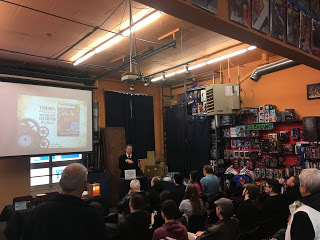 Presenting to the crowd at the book launch.It is, in every way, the bridge across the gap in this blog's decade of research. If you were to start reading every post I made from 2008 to the end, you'd see that there's a gap between 2012 and today. The posts are sporadic, and 2017 is the one year with no posts at all. Where are all those posts? In the book. All my writing energy from 2015-2017 went into creating this book, and 2018 was a year to recover from it.
Presenting to the crowd at the book launch.It is, in every way, the bridge across the gap in this blog's decade of research. If you were to start reading every post I made from 2008 to the end, you'd see that there's a gap between 2012 and today. The posts are sporadic, and 2017 is the one year with no posts at all. Where are all those posts? In the book. All my writing energy from 2015-2017 went into creating this book, and 2018 was a year to recover from it.It's available now through Amazon, Indigo, and other big book vendors. I'd love if you picked one up, and love it even more if you gave it a review. If you're someone with a big reach on social media, I can arrange to have a review copy sent your way, so let me know if you're interested in doing that. You can find me on Twitter as @docperschon.
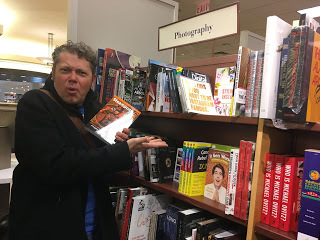 Confused as to why Chapters/Indigo is shelving my book in "Photography."
Confused as to why Chapters/Indigo is shelving my book in "Photography."December 31, 2018
A Decade of Steampunk with Steampunk Scholar
2008: Standing with the members of Legion Fantastique at my first steampunk convention. I'm still in contact with everyone in this photo. That's the best thing about my steampunk travels, by the way: all the amazing people I met.
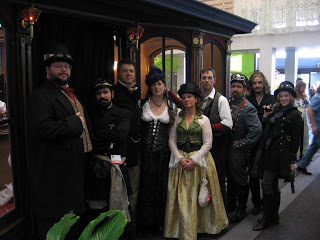 2009: Presenting at my first Speculative-Fiction-related academic conference, the Eaton conference in Riverside, California. That year, the conference was focused on Jules Verne, and I presented the Nemo paper and consequently received a request to submit it for publication. The editorial team for that issue of Verniana included some real giants of Verne scholarlship, including Arthur B. Evans. That was a crucial event in my scholarly career, as it validated what I was doing, but also showed me that I needed to keep attending the fan conventions, as steampunk scholarship was still a rarity, which meant I always just ended up answering the question "What is Steampunk?" at academic gatherings.
2009: Presenting at my first Speculative-Fiction-related academic conference, the Eaton conference in Riverside, California. That year, the conference was focused on Jules Verne, and I presented the Nemo paper and consequently received a request to submit it for publication. The editorial team for that issue of Verniana included some real giants of Verne scholarlship, including Arthur B. Evans. That was a crucial event in my scholarly career, as it validated what I was doing, but also showed me that I needed to keep attending the fan conventions, as steampunk scholarship was still a rarity, which meant I always just ended up answering the question "What is Steampunk?" at academic gatherings.

2010: While Gail Carriger and I would revisit reading from her work together years later, this first time at Steamcon II remains one of the best memories I have of these 10 years. She read the narration, I read the male dialogue. It's on Youtube, split into five sections, if you're interested in seeing it.
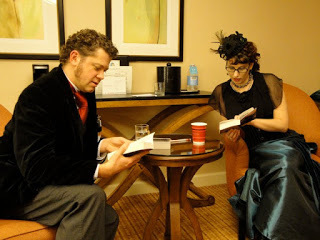
2011: This photo was taken by Lex Machina (my fave steampunk photographer) at the one and only Canadian National Steampunk Exhibition in Toronto, and it became the promotional photo I've used ever since. I should probably get a new one, but it's tough to top Lexi's work, even if I have lost weight since.
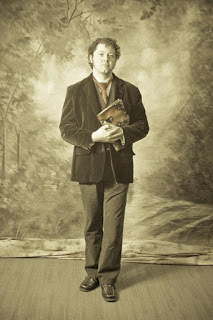
2012: While the blog originally stated the Steampunk Scholar research would be a five year mission, I did it in four. I walked across the stage in November with a PhD in Comparative Literature and a dissertation on steampunk (as well as a chapter in the newly released Steaming into a Victorian Future the first academic steampunk anthology), ready for whatever would come next. At the time, I assumed I'd move on from steampunk to other areas of speculative fiction.

2013: The year without steampunk? Almost! But I was able to return to the Eaton conference (I presented on Gareth Edward's Monsters in light of Susan Sontag's "Imagination of Disaster), but I finally got to meet steampunk luminaries Jaymee Goh and Jess Nevins in person, after years of online interaction!

2014: The Return of the Steampunk Scholar! I was invited to several events this year to talk about steampunk, and all were shocking surprises. From speaking to astronauts and space industry people to German studies grad students, to Sweden's comic-con, Swecon, it was a wild and crazy year. The Swecon event was the most memorable though, with its steampunked steam train and train museum venue.

2015: This was arguably the year without steampunk. After the excitement of presenting abroad in 2014, this year was steamless, until, right before the end of the year, I received the email asking if I'd be interested in writing a book about steampunk for Applause Press. That offer came around the same time we made our first batch of "Smoking Bishop," a mulled wine we discovered while listening to A Christmas Carol on our vacation in British Columbia. That's the most steampunk moment of 2015 before the book offer. It had really felt like that chapter of my life was over. But that was not the case...

2016: While I was actually working on my book most of the year (and consequently not posting here), the autumn of 2016 saw the release of yet another steampunk anthology I had a chapter in, and it's my proudest academic publication yet. It was an article debunking the idea that early steampunk writers James Blaylock, K.W. Jeter, and Tim Powers were dark and political. I'm also proud to have "stood" among the great steampunk thinkers who contributed to this volume.
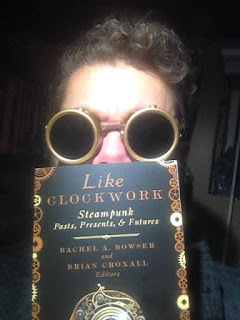
2017: A year almost entirely devoted to writing the book, which was an ordeal. I didn't present anywhere, and didn't post here at all (the only year that happened). But right after I finished the book, I ended up in New York, where I got to meet another long-time steampunk colleague in person: Diana Pho! She gave me a tour of the Tor offices and we went for dessert!

2018: Predictably perhaps, the steampunk highlight of 2018 was the release of my book Steampunk FAQ (at Happy Harbor Comics in Edmonton, pictured below), which is the cherry on top of a five-year mission that became a ten-year mission. I know steampunk isn't done with me yet, and I'm glad--I wouldn't be where I am today if I hadn't decided on steampunk instead of "dystopia" for my PhD dissertation. Thanks to all of you who have been a part of that journey. I don't know where it goes from here, but it's been a fantastic voyage so far.

Full steam ahead into 2019!
December 13, 2018
Mortal Engines

I saw award-winning fantasy author Tim Powers speak at the first Steamcon steampunk convention in 2009, where he was asked about the then-forthcoming Pirates of the Caribbean 4, a film adaptation of his pirate fantasy novel, On Stranger Tides: Was he worried about what Disney would do to his book?
"No," Powers answered, grinning. "Because if they do a good job, we'll have two good stories."
I love telling that story to my students as a response to the idea that the book is always better than the movie. Books and films are different media. As fellow Canadian scholar and literary theorist Linda Hutcheon outlined in her Theory of Adaptation, they are different modes of engagement: telling and showing. That isn't to say there isn't such a thing as a good or bad film adaptation of a book: it's simply that deviations from the book aren't necessarily the criteria for the quality of the film.
In the case of Pirates of the Caribbean: On Stranger Tides, I do not think Disney was successful in producing a second good story. Powers' novel remains the only version of that tale I will return to. This is not the case with Christian Rivers' cinematic adaptation of Philip Reeve's steampunk YA novel, Mortal Engines. And not only did I enjoy what is, to some degree, a "second good story," I would watch it again, and will certainly do so upon purchasing the movie (likely on Blu Ray for all the special features on the film's production).
If initial critical responses are an accurate indication, I'm in the minority here: I've seen all sorts of clever put-downs for Mortal Engines: it runs out of steam, can't keep the engine going, it's a "clunker." I'll give the critics points for connecting their invective to the narrative of city-eating-cities on traction wheels pursuing each other. But I can't agree with their final assessments of the film as 2 out of 4 stars or a "C" grade. And maybe that's because I read the book, and could fill in some of the narrative gaps; but my whole family enjoyed the film and were shocked to know it had received a "rotten" rating on Rotten Tomatoes.
 I concede that Mortal Engines has some narrative gaps, likely evidence of what got left behind on the cutting room floor (I'm hopeful for a director's cut), but they never completely derailed the film. Reeve's book is, despite a comfortably readable length, madly ambitious in its narrative scope. Reeve deftly weaves a huge cast of characters and multiple plot threads which proved too much for two hours of run time. I'm increasingly convinced that novels are the worst subject matter for films: adequate adaptation requires a miniseries at least. Mortal Engines could easily be adapted as six episodes of television.
I concede that Mortal Engines has some narrative gaps, likely evidence of what got left behind on the cutting room floor (I'm hopeful for a director's cut), but they never completely derailed the film. Reeve's book is, despite a comfortably readable length, madly ambitious in its narrative scope. Reeve deftly weaves a huge cast of characters and multiple plot threads which proved too much for two hours of run time. I'm increasingly convinced that novels are the worst subject matter for films: adequate adaptation requires a miniseries at least. Mortal Engines could easily be adapted as six episodes of television.But the big money seems to still be in theatres, despite all our binge watching. And so we have a Mortal Engines film with the streamlined run time of 111 minutes. And maybe this is why I'm as impressed as I am by the film, despite those narrative gaps: it packs a lot of content into those 111 minutes.
The first 20 minutes will likely be a case study for how to adapt books into film the next time I teach on adaptation studies. Even if a review gave the film a poor score, most praise the opening chase sequence. It's breathtaking. Because most of these critics haven't read the book (they admit as much) they can't tell you how well the film sets up all the moving parts of the story during this sequence. It is not simply an adaptation of the first chapters of the novel, it is adapting later portions of the book, conveying massive amounts of world-building information through visual storytelling, not cumbersome expository dialogue, as well as setting up character motivations with a concision that deeply impressed me.
A striking instance of this blending of content is early in the film, where two characters chase each other through one of these traction cities being dismantled inside a larger traction city. We've just seen the smaller city captured, and now we're wondering what the larger one will do with it. But instead of slowing down the story to have characters explain the process or watch as it happens, Rivers stages the reveal of a traction city's deconstruction in the middle of a chase. It conveys plot and world building simultaneously, a technique used throughout the film. And rightly so: films are the showing medium, not really the telling one.

I think this is related to why critics are being so hard on Mortal Engines, and it's something I see in literary studies frequently. There are a few points to be made here, so bear with me. First, most North Americans are taught how to interpret narrative in high school through the lens of the novel, and most often, a realist literary novel. It's unlikely many high school curricula have adopted post-apocalyptic steampunk books for their high school LA courses. Second, most film studies classes focus on "great films," which, in my experience, are obscure and artsy in ways most popular film is not. I've seen very few courses at the post-secondary level devoted to popular novels, let alone popular film (it's still hard enough getting the green light to teach film at all). I assume many film critics went to post-secondary for Communications or English, and got an education along these lines.
Consequently, their criteria for what makes a great work of speculative cinema might be flawed. When I teach speculative fiction (science fiction, fantasy, and horror), we talk about the importance of world building. It's a job speculative fiction has that realist fiction does not. I don't have to explain what a toaster is, for example, not even in a movie where cities eat other cities. But in a movie where cities eat cities, I might use a toaster, as Mortal Engines does, to tell you about this world that is so removed from our own: that this movie takes place in a far future where toasters are relics, things of the distant past. Accordingly, a movie like Mortal Engines has to build a convincing world quickly and mostly through visuals, and Rivers' film does so, rather successfully. Beyond worldbuilding, speculative fiction has the massive task of generating verisimilitude, another thing a realist film or novel doesn't have to work as hard at. The task is compounded in Mortal Engines by the sheer scale of its ludicrous premise.
 Like Reeve's book, however, Rivers' film achieves this: while I know the idea of a massive traction version of London is wildly improbable, if not impossible, I believed in it for 111 minutes. And that is an achievement worthy of something better than a C grade. As I've been implying, moviegoers and movie critics seem to use the same criteria they do for realist novels and realist films when they read speculative novels or see speculative film: character, plot, theme, etc. And while Mortal Engines attempts to check those boxes, it has to leap the hurdle of worldbuilding and verisimilitude before it can get to those other ones. Given how big the first two hurdles are, you have to give Rivers props for getting to character and theme at all, but he does. Not as well as he might have, but well enough to deserve a better assessment than he's getting. But I digress, and may be lapsing into apologetic.
Like Reeve's book, however, Rivers' film achieves this: while I know the idea of a massive traction version of London is wildly improbable, if not impossible, I believed in it for 111 minutes. And that is an achievement worthy of something better than a C grade. As I've been implying, moviegoers and movie critics seem to use the same criteria they do for realist novels and realist films when they read speculative novels or see speculative film: character, plot, theme, etc. And while Mortal Engines attempts to check those boxes, it has to leap the hurdle of worldbuilding and verisimilitude before it can get to those other ones. Given how big the first two hurdles are, you have to give Rivers props for getting to character and theme at all, but he does. Not as well as he might have, but well enough to deserve a better assessment than he's getting. But I digress, and may be lapsing into apologetic.But maybe an apologetic is precisely what I'm aiming at. After all, I know the professional critics have written this one off. And I haven't. I really liked it. Time might reveal I even love it. I agree with William Bibbiani of The Wrap who argues Mortal Engines will likely end up in the company of films like Starship Troopers, Dark City, and Speed Racer: a cult classic, or a film that will one day be praised where it was critically panned (I'd cite Lynch's Dune here as well).
 One of my personal tests for a film is whether it haunts me the next day. For example, I wasn't haunted by the imagery of the financially and critically successful Avengers: Infinity War. I'd seen it all before, superheroes punching other superheroes, and none of it stayed with me the next day, or the day after that. Mortal Engines, on the other hand, haunts me as I write this. I'm haunted by the image of a panoramic shot of the great traction city of London, of the main characters stumbling through a traction tread so huge, it looks like a dry riverbed. I'm haunted by Hera Hilmar's performance as Hester Shaw (whose role has graduated to protagonist in the film, not one of the several leads in the book), by the effects used to realize the Frankenstein-like Shrike, of the beauty of the bright red airship Jenny Haniver, a steampunk cross between vintage float plane and Chinese junk, and of her pilot, Anna Fang, who struck me like an homage to the hero of Trigun. Mortal Engines is a wild mix of image and idea, and I love it for its audaciousness.
One of my personal tests for a film is whether it haunts me the next day. For example, I wasn't haunted by the imagery of the financially and critically successful Avengers: Infinity War. I'd seen it all before, superheroes punching other superheroes, and none of it stayed with me the next day, or the day after that. Mortal Engines, on the other hand, haunts me as I write this. I'm haunted by the image of a panoramic shot of the great traction city of London, of the main characters stumbling through a traction tread so huge, it looks like a dry riverbed. I'm haunted by Hera Hilmar's performance as Hester Shaw (whose role has graduated to protagonist in the film, not one of the several leads in the book), by the effects used to realize the Frankenstein-like Shrike, of the beauty of the bright red airship Jenny Haniver, a steampunk cross between vintage float plane and Chinese junk, and of her pilot, Anna Fang, who struck me like an homage to the hero of Trigun. Mortal Engines is a wild mix of image and idea, and I love it for its audaciousness.Is it perfect? No. There are several missteps, but as I said at the outset, none of those utterly ruin the film. They're hiccups along the way, probable studio interference to trim the film to a run time that gets more butts in seats. I'll admit I prefer the villain of the book to the villain of the film, and wished the screenplay had stuck to Reeve's dialogue for Hester's last line, but those preferences didn't ruin my experience of seeing London pursue and capture Salthook, of our heroes escaping from the Shrike, the steampunk Terminator, or of the rebel pilot Anna Fang, single-handedly managing her own rescue from would-be bounty hunters. A few days ago, I had one good story in the novel of Mortal Engines. Today, I have two, and I'll be revisiting them both in the years to come.

October 20, 2016
I Am Writing A BOOK.

When I was in grade four or five, I sent a letter to a writing college. I'd been subscribing to Writer's Digest (no, for real) for a few months, and had been dreaming of going to one of the writing schools that advertised in its pages. My parents, always supportive, didn't disabuse me of my intentions. They let me write up my request letter, fill out the application, and choose a sample of my writing to send off. They never said, "you're too young." They just let me dream.
I traded that dream for that of being a rockstar: in the 1990s, in my 20s, I aspired to a record contract and touring around the world, though all I ever achieved was a handful of indie CDs, and local opening spots for Big Sugar, 54-40, and Grapes of Wrath. I'm proud of the writing I did for those songs, but it still wasn't becoming a published writer.
I also went to Bible College and became a youth pastor (I know, bizarre combo). And near the end of that career, I wrote a bunch of articles for Youthworker, which was the magazine on doing ministry with teens and university age folks. I never received a rejection letter - just cheques. And that felt pretty good. But it still wasn't what I'd wanted to do - write my own book.
When I started graduate school, I knew the end result would be a book length paper. First, my MA on Pan's Labyrinth, and then my PhD on steampunk. I met lots of writers, and wrote about their work, but I still wasn't publishing my own. I was excited to get my first academic publications, and pleased to be among the first to be published in academic anthologies on steampunk. But watching the struggles of all my writer friends, even the Cinderella stories, I wasn't in any hurry to go hunting for an agent, and then toiling to see my book see the light of day. After all, I was over 40, and was planning to just sit back and take things easy. I thought maybe I'd start a web comic, or rework the novel I blogged online in 2007.
And then in December of last year, I received an email from Robert Lecker of the Robert Lecker Agency. He was looking for someone to write a book about steampunk. Suddenly, without warning, without any struggle or searching, I had an agent asking me if I wanted to write a book about my area of specialization. I looked into it and, after a short period of deliberation, said yes. After a few drafts of the proposal I found myself reading over a contract and shortly after, signing it.
So now I'm writing a book. I've been working on it since May, but I didn't want to make a formal statement until I was well into it. Until I knew it was for real. Because saying the words "my agent" and "my editor" kept sounding strange. But I've hit the half-way mark, and the feedback from my editor is positive. I know when the book is likely to be released (tentatively - March 2018). I've got marketing/promotional forms to fill out. I'm now a paid, professional writer. And I have a book coming out.
It's part of a pop-culture series from an imprint of the Hal Leonard company (yes, the people who do the sheet music). Initially, it was under Backbeat Books, but they mostly handle music, whereas Applause, the imprint I'm with now, handles more literature and film. In both cases, the series is called "FAQ." So you have Doctor Who FAQ by Dave Thompson and Modern Sci-Fi Films FAQ by Tom DeMichael. Consequently, my book is going to be, simply, Steampunk FAQ. And I'm pretty jazzed about that, because I didn't really want to write another academic piece on the subject. I wanted to write everything I think about steampunk and then a little bit more. And that's what I'm doing.
If you've followed this blog, you might think, "What else do you have to say about it?" And I wondered the same thing last December. I wondered it even more when I was told not to recycle any material I'd previously published. I wondered it I could do it.
Turns out, there's lots more to say about steampunk. And there are a few things I've learned that I know no one's ever noticed before, so I'm excited to reveal these things to you all in a year and a half. In the meantime, I've got a chapter in another academic anthology coming out this fall: Like Clockwork: Steampunk Pasts, Presents, and Futures, edited by Brian Croxall and Rachel Bowser. I'm super proud of the my chapter on the seminal steampunk of Michael Moorcock, James Blaylock, K.W. Jeter, and Tim Powers. If you'd asked me last year if I ever planned to write a book, I'd have said "no way - I'll just keep writing articles for anthologies."
Because a book seemed too big, too hard, too much. And it's been a hell of a lot of work so far. And there's miles yet to go. I've written on steampunk anime and comics and steampunk antecedents in film and literature, but there are chapters remaining to be written on steampunk music and fashion.
I did get a reply from that writing college, much to everyone's surprise. They thanked me for my application, but graciously declined it. They told me my writing showed promise, and they'd love to get an application from me when I turned 18. I never forgot that letter, even though I no longer had it when I graduated from high school in 1989. And I never forgot my dream of being a writer, even if it had gone the way of so many dreams: something you'll do "someday."
Well, someday is here. And though the blog lies dormant, I wanted you all to know my news. To know why I'm not updating here. I'm still updating, but you'll have to wait to read that post. It's going to be a doozy.

May 16, 2016
Clockwork Lives by Kevin J Anderson and Neil Peart

One of my great frustrations in my final year of studying steampunk was that, although I had Rush's Clockwork Angels to keep me company as I finished writing my dissertation, I never got around to reading Kevin J. Anderson's novel that accompanied the concept album. Thankfully, I was given a second chance in the form of the sequel, Clockwork Lives, which is first and foremost a gorgeous book. People who enjoy books as objects, especially when that object looks like the book inside the story you're holding, will appreciate the quality of the hardback of Clockwork Lives. It's designed to look like the alchemical book that Marinda Peake the protagonist of the story's frame narrative is carrying around. The quality of the paper, the fonts, and the illustrations all make for a very aesthetically pleasing art object insofar as the book as object goes.
The frame narrative of Clockwork Lives is Marinda's journey to collect stories. Marinda is very hobbit-like. She's lived out her life in mediocrity, enjoying the monotony of life in Lugtown, far from the great goings-on in Peart and Anderson's steampunk world. When her father dies, he passes this alchemical book along to her, with the mandate to fill it with stories. His is the first entry, "The Inventor's Tale." A drop of a person's blood on the pages of her alchemical book results in their story being written out in red letters. The premise is great, even if Anderson's prose doesn't always live up to the fictional conceit; he's a good storyteller, but his style isn't nuanced enough here to convey the breadth of voices telling their stories. Some might argue that's the result of the book telling their story, instead of the people themselves telling it. Nevertheless, when a thief who's lived his whole life on the streets is using the word "ostentatious," I'm experiencing some readerly dissonance. That stylistic flaw may not bother some readers, so it's a minor detractor. Max Brooks' World War Z had a similar problem, and it never bothered readers.
For me, the frame narrative is the weakest point. Clockwork Lives ultimately falls short of an attempt to be a steampunk Canterbury Tales, which it evokes, if only in the titles of the stories - "The So-and-sos-tale." See, a frame narrative is supposed to do more than act like Elvira, Queen of the Dark introducing tonight's feature film. It's supposed to have something to do with those stories. The frame speaks to the tales and the tales speak back into the frame. I kept waiting for this to happen. I suppose that someone could argue that all the stories along with Marinda's work under the thematic idea in the book's epigraph: "Some lives can be summed up in a sentence or two. Other lives are epics." All the stories we read here are ostensibly epics in the way that epigraph is meant to be taken. They are tales of people who stepped outside the norm, who stepped to the beat of a different drummer (literally, since Neil Peart was the drummer for Canadian superband RUSH). This idea is certainly contained in the stories, sometimes too much so. I felt like I was being bludgeoned by the "rebels in a perfect dystopia" idea. What would have been really interesting would have been to have heard from those who fit into that world, rather than getting the lives of all the iconoclasts. That's a story worth exploring - how does one become a goose-stepping yes man?
I suspect Marinda's story is supposed to transform from a two line summary to an epic, but it's ultimately unengaging and lacking in narrative drive, even after she gets her rebellious groove on. And ultimately, that thread of raging against the steampunk machine isn't enough to string these stories together. Since Anderson is mainly a plot-focused, not character focused writer, I would at least expect there to be some sense of narrative cohesion to the frame narrative. I adore his Captain Nemo: The Fantastic History of a Dark Genius. And because of that book, I wanted to like Clockwork Lives. I liked the beginning. I like some of the stories. I never felt like it quite came together. By the final third of the book, I started skimming, just wanting to get to the end so I could be done with it.
However, if you read the individual stories without the frame narrative, I suspect it will be more than satisfying for most fans of light steampunk. I especially enjoyed "The Astronomer's Tale," "The Bookseller's Tale" and "The Fortune Teller's Tale." I also suspect that this book would be tremendously satisfying for younger readers who don't give a rat's ass about frame narratives and cohesion. I'll read Clockwork Angels before I make my final judgement call, but if Clockwork Lives is any indication, this is a steampunk world best experienced through Peart's lyrics, drumming, and bandmates' music.
February 19, 2016
Swecon 2014: Steampunk Festivalen
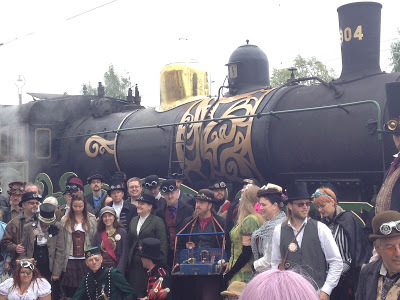
This post is part of Steampunk Hands Around the World, 2016.
In 2008, the website Gizmodo announced that "steampunk is dead." This was a bit of a disappointment to me, given that I was just starting my PhD research into steampunk. And while it's not uncommon for students of literature to study dead things: dead movements, dead authors, dead languages, I'd just attended my first steampunk convention and had a lovely time. I knew I was arriving late to the steampunk party, but I wasn't ready for it to be over. Six years later, the four days my wife and I spent among Steampunk Swedes at the Rail Museum in Gävle, Sweden, are certain proof that Gizmodo, and every other steampunk doomsayer was dead wrong.
When I was first invited as a Guest of Honor (aka hedersgäst) to the Steampunk Festival in Gävle, I was sure someone had made an error. Even though I had known organizer Anna Davour for years online, I wondered if she understood that I lived on the far side of Canada. The flight alone would cost a pretty penny, to say nothing of hotel, per diem, etc. I'm an English instructor--I'm not a famous Maker like Jake von Slatt, I'm not an entertaining performer like Professor Elemental, nor a talented artist like Myke Amend, or famous novelist like Gail Carriger. While I've attended a number of steampunk events, I've received more invitations than I've said yes to, for the simple reason that only one ever offered to help me buffer my travel costs, let alone pay for a Transatlantic Flight. I agreed to attend, fully convinced that the shoe would fall at some point and I'd be informed there'd been a mistake and I wouldn't be going.
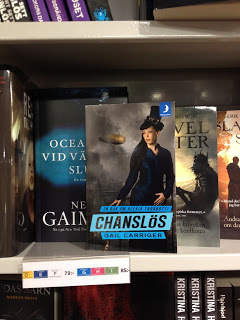 Gail's so famous, you can find her books in Gävle!In the intervening year, this little Steampunk Festival was accepted to be Swecon, Sweden's national nerd event, with other Guests of Honor who made more sense to me, like writers Cory Doctorow and Chris Wooding. As it happened, only Cory seemed to know why he was there, while Chris, Miriam Roček, and myself would all confess wonder at how we ended up in the land of IKEA, ABBA, and the late Stieg Larsson. Through the magical miracle of Aeroplan miles, my wife Jenica was able to attend with me, and in late June 2014, after our first (and exceedingly relaxing) Transatlantic flight, we touched down on Swedish soil.
Gail's so famous, you can find her books in Gävle!In the intervening year, this little Steampunk Festival was accepted to be Swecon, Sweden's national nerd event, with other Guests of Honor who made more sense to me, like writers Cory Doctorow and Chris Wooding. As it happened, only Cory seemed to know why he was there, while Chris, Miriam Roček, and myself would all confess wonder at how we ended up in the land of IKEA, ABBA, and the late Stieg Larsson. Through the magical miracle of Aeroplan miles, my wife Jenica was able to attend with me, and in late June 2014, after our first (and exceedingly relaxing) Transatlantic flight, we touched down on Swedish soil. 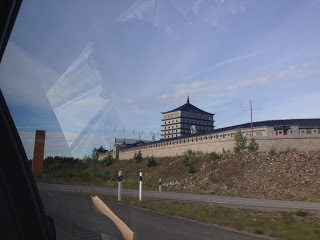
Our journey from the Stockholm Arlanda Airport was facilitated by Stefan Gemzell, who proved to be both capable chauffeur and tour guide. Along the E4 motorway to Gävle, Stefan regaled us with all sorts of trivia about Sweden, most notably the Dragon Gate hotel, which has the highest WTF? factor of anything I saw on this trip. In short, it's a hotel that looks like the set for a period Chinese epic, but has never had any visitors, because, although it's been there since 2004.


Since we arrived a few days early at Swecon's request, we were able to fully appreciate and enjoy the lovely Elite Grand Hotel and a few of the sights of Gävle. It's apparently considered a bit of a backwater, given how people kept apologizing that the event had to take place there, but for Jenica and I, the combination of late night/early morning sunshine, old world architecture, and abundance of cycling and walking paths made for a very relaxing preamble to Swecon. We consequently kicked our jet lag before the con began.
 Me standing with one of many Gävle goats around town. Google that. It involves fire.The event itself was held at the Sveriges Järnvägsmuseum, the Swedish Railway Museum, which is one of the best kept rail museums I've ever been to. And because of this, the Swecon Steampunk Festival had something no other steampunk event I've ever been to had: its own train. Yes, there may have been steampunk events where a steam train was present, but not like this one. And just like me, you'll have to wait for the reveal of that particular train. I learned of it upon my first night in Gävle from Erik Andersson, a great mountain of a man with a heart of gold and a laugh you'd expect a Viking (for the record, Swedes are really hospitable and humble. It's hard to imagine them running up on your shore from a longship with a broadsword in hand). Erik and his crew of steampunk train apprentices had been working feverishly to have the train ready for its reveal at the festival, and he was clearly very proud of it.
Me standing with one of many Gävle goats around town. Google that. It involves fire.The event itself was held at the Sveriges Järnvägsmuseum, the Swedish Railway Museum, which is one of the best kept rail museums I've ever been to. And because of this, the Swecon Steampunk Festival had something no other steampunk event I've ever been to had: its own train. Yes, there may have been steampunk events where a steam train was present, but not like this one. And just like me, you'll have to wait for the reveal of that particular train. I learned of it upon my first night in Gävle from Erik Andersson, a great mountain of a man with a heart of gold and a laugh you'd expect a Viking (for the record, Swedes are really hospitable and humble. It's hard to imagine them running up on your shore from a longship with a broadsword in hand). Erik and his crew of steampunk train apprentices had been working feverishly to have the train ready for its reveal at the festival, and he was clearly very proud of it. 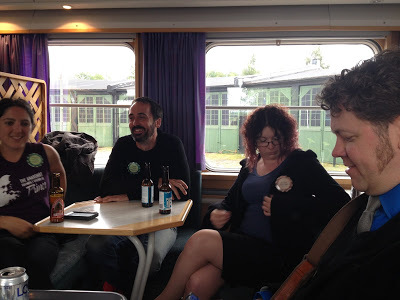 Gillian Redfearn checks out her guest pass, while the GoHs all meet for the first time
Gillian Redfearn checks out her guest pass, while the GoHs all meet for the first time
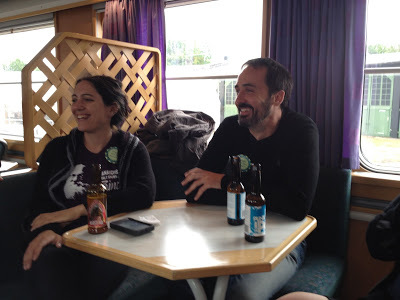 Miriam Roček and Chris Wooding
Miriam Roček and Chris Wooding
 Cory Doctorow, just before the GoH panel.
Cory Doctorow, just before the GoH panel.The night before the festival, the Guests of Honour gathered with the organizers and volunteers for a supper, so that we wouldn't have to be strangers for the weekend. Following a robust conversation about many things geek with a few of the organizers at my end of the table, I met Chris Wooding the night before, which was a bit of a fanboy moment for me, as I loved Retribution Falls, the first book in Chris's Ketty Jay series. Thankfully, Chris turned out to be a great guy, and we enjoyed drinks, food, and great conversation with Chris and his editor, Gillian Redfearn many times over the course of the weekend. However, the GoHs were spread around the table at the mixer, so it was only moments before the first panel on Friday night that I was properly introduced to Cory Doctorow and Miriam Roček, as we quickly compared notes for the opening Guest of Honour panel. I'll openly admit to being just a little intimidated by both Cory and Miriam, as they are on the opposite end of the question of whether steampunk should be punk-political. I'm not a prescriptivist, I'm a descriptivist, and while I know that there are many steampunks like Cory and Miriam, I know there are just as many who enjoy a good bit of fun without politics or activism in the conversation. I think it was that difference that made for a great GoH panel, with Chris and I representing one end of that continuum, and Miriam and Cory representing the other. It showed that the Swedes know that steampunk is a multifaceted fandom, and celebrated that diversity. And thankfully, our differences didn't distance us, and I enjoyed getting to know all my GoH colleagues over the course of the weekend.
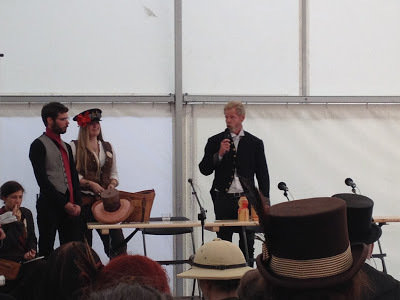 The director of the Rail Museum welcoming us all
The director of the Rail Museum welcoming us all
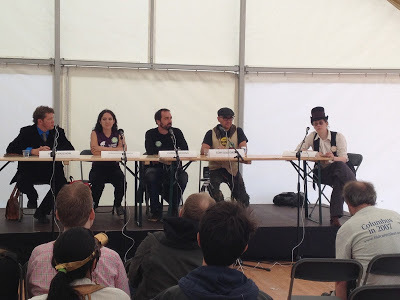 The Guest of Honour Panel - Me, Miriam, Chris, and CoryAt the opening ceremonies, the head of the Swedish Railway Museum spoke of how the event was the perfect blend of things he loves: trains and Tolkien. It was a great statement to kick off the weekend. Then the organizers brought out "the Spirit of Swecon," which had been bottled the year before at the end of the 2013 event. I'd never seen anything like it, and I thought it a wonderful ritual to begin a convention. After all, most fan cons are essentially religious gatherings, involving pilgrimage (journey to the con), pageantry (cosplay), performance (panels, presentations, and LARP!), sacred texts (booksellers) and sacred icons (steampunk stuff!).
The Guest of Honour Panel - Me, Miriam, Chris, and CoryAt the opening ceremonies, the head of the Swedish Railway Museum spoke of how the event was the perfect blend of things he loves: trains and Tolkien. It was a great statement to kick off the weekend. Then the organizers brought out "the Spirit of Swecon," which had been bottled the year before at the end of the 2013 event. I'd never seen anything like it, and I thought it a wonderful ritual to begin a convention. After all, most fan cons are essentially religious gatherings, involving pilgrimage (journey to the con), pageantry (cosplay), performance (panels, presentations, and LARP!), sacred texts (booksellers) and sacred icons (steampunk stuff!). 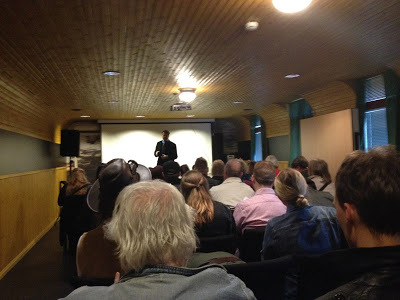 Presenting for the first time at the weekendAfter our GoH panel, we all went our separate ways: I was off to give my first solo presentation of the weekend, "Useful Troublemakers: New Women in the Novels of Gail Carriger and Cherie Priest." Here's the blurb from the program about that presentation:
Presenting for the first time at the weekendAfter our GoH panel, we all went our separate ways: I was off to give my first solo presentation of the weekend, "Useful Troublemakers: New Women in the Novels of Gail Carriger and Cherie Priest." Here's the blurb from the program about that presentation: Steampunk's retrofuturist gaze is almost uniformly associated with technology; consequently, steam punk retrofuturism rarely realizes the historical aspirations of the nineteenth century. Instead, it ends up being the way we imagine the past seeing the future. While these imaginings often take the shape of dirigibles and clockwork beings, they have the potential to reimagine the social spaces of the past, as Cherie Priest and Gail Carriger's steampunk novels do with women in the nineteenth century.The presentation went really well, despite an absence of laptop for the new slideshow I'd built just for Swecon (so I'm dying to present this one again!). Attendees were really engaged, and asked great questions. I was also interrogated by an attendee about why I thought it was appropriate for a white male to be presenting on women's rights, to which I replied, "I have a platform. You want to be upset about me using it for that, go ahead. But so long as I have the mic, I want to make it count." I don't want to "mansplain," but I do want to be an advocate and ally. So much for me not being prescriptive about politics in my steampunk!
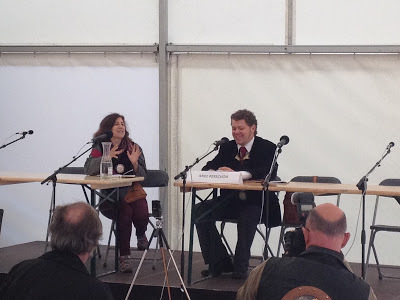 Being interviewed by Anna Davour
Being interviewed by Anna DavourSaturday dawned cold and grey, around 14 degrees Celcius and rainy, which we were told was unseasonably chilly. Thankfully, steampunk garb is built for colder, not warmer weather. I'd rather fight a bit of chill than sweat through my waistcoat. I only wish I'd packed fingerless gloves, since my first panel of the day was my GoH interview with Anna Davour. I'd met Anna on my first website, Gotthammer, so it was like a reunion with an old friend rather than a first-time meeting. The Guest of Honor interviews were in a large tent outside the Train Museum, and despite my Canadian fortitude for cold, I found myself shivering by the end of our talk. Nevertheless, the attendees were warm, and the interview felt more like a conversation, as these things should.
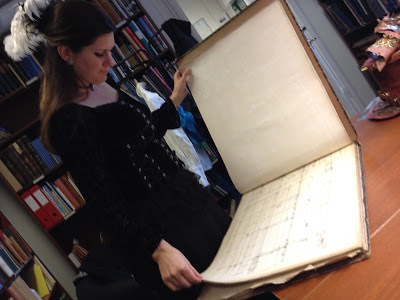 Jenica discovers train schematics in the Rail Museum library - the "Green Room"And the Green Room was warm. And it had fika. Fika is a Swedish word that is very similar (or so I was told) to our idea of "going for coffee." But Fika also involves pastries, in this case cinnamon buns, and the chilly GoHs and panelists gathered between presenting duties to grab a coffee, a tea, and a cinnamon bun. We were housed for these gatherings in the Rail Museum's library, which was filled with Swedish books on trains. Jenica located some really cool diagrams as well. We met some lovely local authors like Nene Ormes (who I absolutely adore - I wish her books were in translation!) and Oskar Källner, with conversations ranging from grammar to Game of Thrones (in one of these, the ever-humble Gillian Redfearn, who is also George R.R. Martin's UK editor, cheekily whispered, "should I text him and ask?" when questions were being asked about the future of some of the characters). Some of my best memories of the weekend are of sitting around the table in that library.
Jenica discovers train schematics in the Rail Museum library - the "Green Room"And the Green Room was warm. And it had fika. Fika is a Swedish word that is very similar (or so I was told) to our idea of "going for coffee." But Fika also involves pastries, in this case cinnamon buns, and the chilly GoHs and panelists gathered between presenting duties to grab a coffee, a tea, and a cinnamon bun. We were housed for these gatherings in the Rail Museum's library, which was filled with Swedish books on trains. Jenica located some really cool diagrams as well. We met some lovely local authors like Nene Ormes (who I absolutely adore - I wish her books were in translation!) and Oskar Källner, with conversations ranging from grammar to Game of Thrones (in one of these, the ever-humble Gillian Redfearn, who is also George R.R. Martin's UK editor, cheekily whispered, "should I text him and ask?" when questions were being asked about the future of some of the characters). Some of my best memories of the weekend are of sitting around the table in that library. 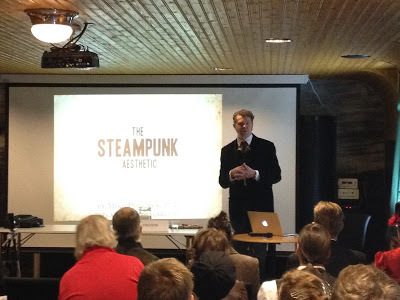 "What is Steampunk?"My presentation on "What is Steampunk?", my tried-and-true explanation of the steampunk aesthetic went off without a hitch, and as these photos can attest, with slides! Again, the attendees were great, and I was consistently surprised by how well Swedes comprehend English. I can't imagine the reverse happening in Western Canada.
"What is Steampunk?"My presentation on "What is Steampunk?", my tried-and-true explanation of the steampunk aesthetic went off without a hitch, and as these photos can attest, with slides! Again, the attendees were great, and I was consistently surprised by how well Swedes comprehend English. I can't imagine the reverse happening in Western Canada. 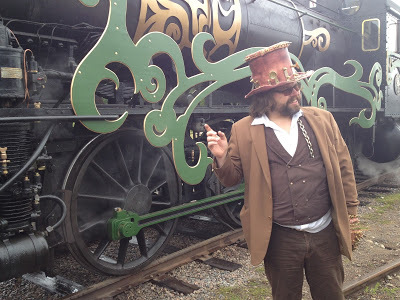 Erik Andersson, in front of Järnsaxa
Erik Andersson, in front of Järnsaxa
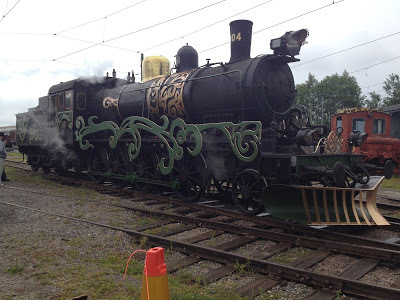 Järnsaxa
Järnsaxa
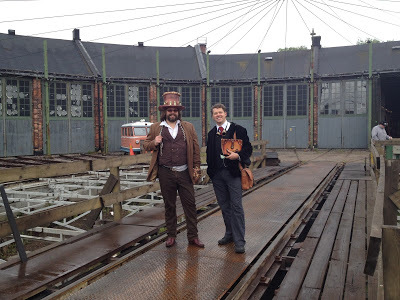 Erik and I standing on the Railway Turntable
Erik and I standing on the Railway Turntable
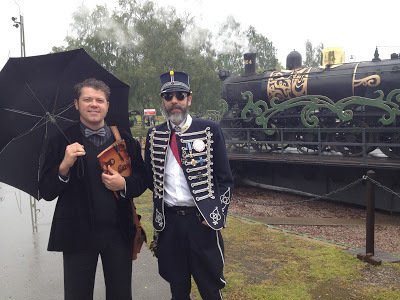 Me, my bowtie, and Matthias Westermark, one of my favorite geeks in the worldThat afternoon, Jenica and I were treated to a preview of Järnsaxa, the train that Swedish steampunks were given permission to decorate. I'd never heard of any other steampunk event getting license to steampunk an actual steam train, so I was pretty excited. Erik Andersson took us onboard to meet Thomas the [Tank Engine] Engineer, who let Jenica pull the steam whistle. It's one thing to see a steam train in a photo or a video. It's another to stand in front of it, seeing the steam issuing out of this massive machine. You really understand why Walt Whitman thought the spectacle of the steam train was worth a poem. Though the weather made some aspects of the weekend more challenging, it made the unveiling of Järnsaxa extra special. For those who question where the steam is in steampunk, it was in high supply at Swecon in 2014. Sadly, Järnsaxa was not a permanent fixture at the Rail Museum, and was returned to its former state a few months after the event, making the photos and videos you can find online the sole record of its existence. A moment of alternate history at the Swedish Rail Museum.
Me, my bowtie, and Matthias Westermark, one of my favorite geeks in the worldThat afternoon, Jenica and I were treated to a preview of Järnsaxa, the train that Swedish steampunks were given permission to decorate. I'd never heard of any other steampunk event getting license to steampunk an actual steam train, so I was pretty excited. Erik Andersson took us onboard to meet Thomas the [Tank Engine] Engineer, who let Jenica pull the steam whistle. It's one thing to see a steam train in a photo or a video. It's another to stand in front of it, seeing the steam issuing out of this massive machine. You really understand why Walt Whitman thought the spectacle of the steam train was worth a poem. Though the weather made some aspects of the weekend more challenging, it made the unveiling of Järnsaxa extra special. For those who question where the steam is in steampunk, it was in high supply at Swecon in 2014. Sadly, Järnsaxa was not a permanent fixture at the Rail Museum, and was returned to its former state a few months after the event, making the photos and videos you can find online the sole record of its existence. A moment of alternate history at the Swedish Rail Museum. 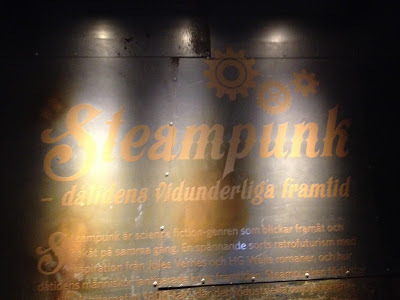 This photo, and the following ones, are all from the steampunk art display at the con.
This photo, and the following ones, are all from the steampunk art display at the con.
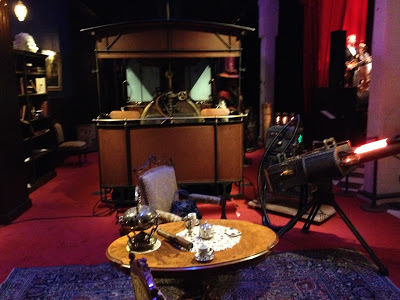


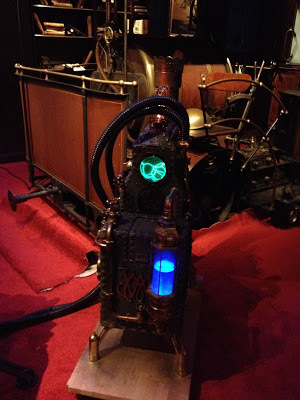

 Saturday culminated in a steampunk ball, which was held in the big tent. The chill of the day was held back by the number of bodies generating heat, and the warm atmosphere of a formal event made glamorous by steampunk finery. It was a rare opportunity for me, to just sit and watch the attendees interact and the magic show, which, thanks to our interpreter Johan Anglemark, was hilarious as well as entertaining. Conventions are a wonderful place to make new friends, and Johan was definitely among those. I was transported back to Steam Powered, my first steampunk convention in the fall of 2008. For the first time since I'd finished my dissertation, I had a sense of why I loved steampunk in the first place. From my admittedly limited vantage point, this Swedish event was bereft of the posturing and gatekeeping I'd seen too much of back in North America: it had the same sense of playfulness I'd experienced at Steam Powered. Even if steampunk was dead back home, it was certainly alive in Sweden.
Saturday culminated in a steampunk ball, which was held in the big tent. The chill of the day was held back by the number of bodies generating heat, and the warm atmosphere of a formal event made glamorous by steampunk finery. It was a rare opportunity for me, to just sit and watch the attendees interact and the magic show, which, thanks to our interpreter Johan Anglemark, was hilarious as well as entertaining. Conventions are a wonderful place to make new friends, and Johan was definitely among those. I was transported back to Steam Powered, my first steampunk convention in the fall of 2008. For the first time since I'd finished my dissertation, I had a sense of why I loved steampunk in the first place. From my admittedly limited vantage point, this Swedish event was bereft of the posturing and gatekeeping I'd seen too much of back in North America: it had the same sense of playfulness I'd experienced at Steam Powered. Even if steampunk was dead back home, it was certainly alive in Sweden. Jenica and I at the Steampunk Ball
Jenica and I at the Steampunk Ball


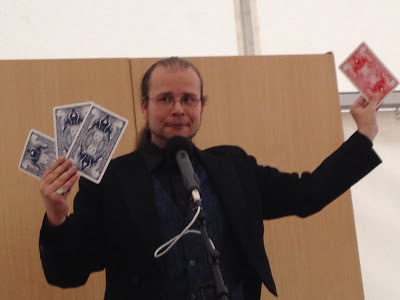

Sunday was another cold and grey day, but my final panel was easily my favorite of the weekend. I came to present at my GoH Speech with several of my best presentations loaded on the laptop, and gave the group the opportunity to choose which one they wanted to hear. By a landslide, they chose my Finding Nemo presentation, the very first piece of research I ever did on steampunk back in the fall of 2008, and the first academic article I published on the subject. Again, I was taken back to Steam Powered, where I gave the presentation that formed the roots of that study. I was transported back to researching at Rice University over the Christmas holidays in 2008: to the Eaton Science Fiction Conference in 2009, for which I built the slideshow utilizing Art Donovan's "Steampunk Mandala." As I was transported, I shared my journey, and the revelations I'd had about steampunk via the character of Captain Nemo. It was an absolutely brilliant time, and the attendees had insightful questions and uplifting encouragement.



I was further buoyed by my GoH Fika in a train car, where I was joined by a handful of con attendees who (much to my surprise) wanted to meet me and have a close conversation with me. The group who came were lovely, and admitted that they too had been taken by surprise by wanting to hang out with the academic. One of them related that he'd been dubious about my inclusion as a Guest of Honor, but after hearing me at the GoH panel the first night, he'd attended most of my panels. It was a wonderful thing to hear, given my own doubts about being a Guest of Honor on the other side of the world. The conversation centered on Swedish LARP, which appears to be LARP on steroids: they told me about a Battlestar Galactica LARP they'd been involved in on a Swedish naval destroyer. I tried to imagine any LARPing group in the United States or Canada getting permission to do performance art on a military vessel, and the image wouldn't come. Correct me if I'm wrong, Internet, but I think the Swedes have taken LARP to a level the rest of us can only aspire to.

 At the closing program, the GoHs were presented with a lovely gift - prints by Swedish artist, Simon Stalenhag. Somehow, despite the decorum of the moment, Chris, Miriam, and I thought it appropriate to pretend they were lightsabers. Anna Davour recaptured the spirit of Swecon until 2015, and then it was time, as it always is at these weekends, to say farewell, which we did at a little pub just around the corner from our hotel. We went and had a drink, sitting across from Erik Andersson and Kristin Thorrud, the woman who'd had the idea to have a steampunk event at the train museum (and who makes some of the best steampunk costumes I've ever seen). I'd never been to a "dead dog party" before, but I certainly understood why they bear that name. It's always hard for me to take leave at the end of a con, and this one all the moreso. When I took leave of new friends at Steam Powered, I knew I'd be back - knew I'd see them again. And I did - at Steamcon and other conventions. But I couldn't imagine getting back to Sweden anytime soon, and so, weary as we were, we stayed as long as we could before returning to our hotel.
At the closing program, the GoHs were presented with a lovely gift - prints by Swedish artist, Simon Stalenhag. Somehow, despite the decorum of the moment, Chris, Miriam, and I thought it appropriate to pretend they were lightsabers. Anna Davour recaptured the spirit of Swecon until 2015, and then it was time, as it always is at these weekends, to say farewell, which we did at a little pub just around the corner from our hotel. We went and had a drink, sitting across from Erik Andersson and Kristin Thorrud, the woman who'd had the idea to have a steampunk event at the train museum (and who makes some of the best steampunk costumes I've ever seen). I'd never been to a "dead dog party" before, but I certainly understood why they bear that name. It's always hard for me to take leave at the end of a con, and this one all the moreso. When I took leave of new friends at Steam Powered, I knew I'd be back - knew I'd see them again. And I did - at Steamcon and other conventions. But I couldn't imagine getting back to Sweden anytime soon, and so, weary as we were, we stayed as long as we could before returning to our hotel.  What happens when geeks get cardboard tubes in their hands.
What happens when geeks get cardboard tubes in their hands.




And over the next day, in stages, we returned to "the real world," leaving the fantastic hyper-Victorian (or hyper-Oscarian, to be properly Swedish in my steampunk) world behind us. We had looked our last on Järnsaxa the steam train, and only glimpsed the Rail Museum as our passenger train flew by a speed Whitman could never have dreamed of. We left our beautiful Grand Hotel behind, bound for a Holiday Inn in London. But despite returning to the real world, I had a renewed sense of the ongoing vibrancy of steampunk. Maybe the fad has died down in North America, but around the world, there are people who are just discovering steampunk for the first time. And when they do, it appears there will always be these gatherings which engage in a moment of alchemical magic, as disparate elements and people meet for a shared love of top hats, goggles, steam contraptions, corsets, and a sense of adventure that gives us the recovery of a lost past, and the escape from a dreary present Tolkien said fantasy should. And in this case, a eucatastrophe, an unexpected happy ending: I'd gone around the world, worried I wasn't the droid they were looking for. I don't know if I was the right Guest of Honor for Swecon in 2014, but the Steampunk Festivalen certainly reminded me once again, that Steampunk is not dead, but alive and well in its fans around the world.

January 31, 2016
Top 5 Steampunk Reads of 2015
It's back! After a long hiatus, I'm finally reading steampunk again in earnest, motivated primarily by the first book on the list this year. Mark Hodder's Burton and Swinburne series restored my faith in steampunk as a genre, and I opened myself up to submissions for review again. While I missed out on some key works of steampunk like Brandon Sanderson's Mistborn: Shadows of Self and Jim Butcher's The Aeronaut's Windlass: The Cinder Spires, Book 1, I certainly read enough to form up the beginnings of a "best of" for steampunk in 2015. I decided not to finish this list until I've finished reading The Geomancer by Clay and Susan Griffith (which I'm enjoying thus far) and Gail Carriger's Prudence, which has been an enjoyable romp on par with her earlier Parasol Protectorate books. But here's the list so far, for those who have missed having me around to help avoid the pitfalls of steampunk reading.
 1. Rise of the Automated Aristocrats by Mark Hodder
1. Rise of the Automated Aristocrats by Mark HodderIf this is the first you've ever heard of Mark Hodder's steampunk novels, you need to go check out books 1-5 before taking on this final installment in one of the best steampunk series in print. I re-read the first two books in the series, and then read my way through the intervening volumes I've missed over the years. While Rise of the Automated Aristocrats is not the best of that series, it does a fine job of wrapping up all six books, while continuing to play the game Hodder started in book 4, when he kept the series running by imagining another timeline with another Burton and Swinburne, along with variant versions of the rest of the characters fans of this series had come to love. The stakes are high, and there are bittersweet losses, but it's a very satisfying conclusion, and one of the few steampunk novels I've read that can lay any serious claim to being called science fiction. Unreservedly recommended, along with all of the books in this brilliant series.

2. The Circlet Press Steampunk Bundle: Four Full-Length Novels & an Anthology by Vinnie Tesla, Petter Tupper, et al.
I reviewed Peter Tupper's lovely steampunk erotica The Innocent's Progress years ago when it was first released, and gave it high praise. This year, I read Vinnie Tesla's The Erotofluidic Age, and found myself jumping from arousal to unrestrained laughter throughout. Circlet Press releases some of the best science fiction and fantasy erotica out there. In my experience (and reviewing steampunk books, I've read more than I ever thought I would), I know no better. I have not read all four books in this bundle, and while the individual books were released in previous years, I wanted to give them the attention they deserve since they've been re-released in this very affordable bundle as eBooks. If you like your steampunk steamy, you will not go wrong with Vinnie Tesla and Peter Tupper. Their erotica is far more than sex with gears slapped on. It's smart speculative fiction about a crucial part of the human experience. In Tupper, it's serious and poignant. In Tesla, it's over-the-top funny, and both are well worth a read.
3. The Art of Assassin's Creed Syndicate
I love Titan Books' art books, and own several, but The Art of Assasssin's Creed was a pleasant surprise when I was sent it for review. Steampunk cosplayers will love the design work in this book for costume ideas. The book is obviously influenced by previous steampunk expressions, but I can say with confidence that it also takes the aesthetic in new directions. There isn't a page in this book that isn't glorious in some way or another, be it a great character design or a panoramic painting of nineteenth century London.
 I also want to give an honorable mention to Rebecca Diem's From Haven to Hell, which is the second book in her Tales of Captain Duke series. I had stated on Twitter that I was no longer taking self-published works, since many of them are so poorly written that they are unreadable. It had become a waste of my time to wade through all the requests I was getting to review books I had no interest in reading. But Rebecca made a plea, asking me to check out her series, which begins with the very entertaining Stowaway Debutante, and I'm happy to say that I'm glad I took her up on it. While Diem's writing chops betray some beginner's flaws, she isn't a bad writer, and her prose is clean and concise in a way that a good page turner should be. Her steampunk world is bright and vibrant, and her characters are brave adventurers who don't have a million flaws (at least, not until you get to book two...). They are a throwback to a simpler time, and in that respect, will likely appeal to young readers, and readers who are young at heart. Nevertheless, while I can't recommend it as the best steampunk I read in 2015, I can say without reservation that it's some of the best indie steampunk I've ever read, and I would recommend her to readers looking for high adventure in small packages. One of the great attractions of Diem's books is that they are short, and consequently really great for young readers who may not be up to the challenge of massive wrist crackers. If nothing else, check out Diem while she's still indie. If this is what she writes like without an editor, she's going to do very well if she ever goes pro.
I also want to give an honorable mention to Rebecca Diem's From Haven to Hell, which is the second book in her Tales of Captain Duke series. I had stated on Twitter that I was no longer taking self-published works, since many of them are so poorly written that they are unreadable. It had become a waste of my time to wade through all the requests I was getting to review books I had no interest in reading. But Rebecca made a plea, asking me to check out her series, which begins with the very entertaining Stowaway Debutante, and I'm happy to say that I'm glad I took her up on it. While Diem's writing chops betray some beginner's flaws, she isn't a bad writer, and her prose is clean and concise in a way that a good page turner should be. Her steampunk world is bright and vibrant, and her characters are brave adventurers who don't have a million flaws (at least, not until you get to book two...). They are a throwback to a simpler time, and in that respect, will likely appeal to young readers, and readers who are young at heart. Nevertheless, while I can't recommend it as the best steampunk I read in 2015, I can say without reservation that it's some of the best indie steampunk I've ever read, and I would recommend her to readers looking for high adventure in small packages. One of the great attractions of Diem's books is that they are short, and consequently really great for young readers who may not be up to the challenge of massive wrist crackers. If nothing else, check out Diem while she's still indie. If this is what she writes like without an editor, she's going to do very well if she ever goes pro.I'll update the list as soon as I've made a decision about the final two spots. But I'm back, people. I'm really back this time.
October 31, 2015
The Greyfriar: Book 1 of the Vampire Empire by Clay & Susan Griffith
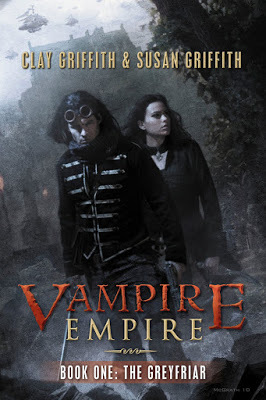
I loved The Greyfriar, the first book in Clay and Susan Griffith's Vampire Empire series. I'm getting that out of the way, so the desire to sing its praises won't get in the way of anything else I have to say about it. I'm sad it took me over a year to get to it (and then a few more years to post the review!), but thankful I had the sequel, The Riftwalker, already waiting to be read when I completed The Greyfriar.
I must confess, I judged this book by it's cover, unjustly dismissing it as the worst kind of publishing opportunism, capitalizing on both the popularity of hunky vampires and steampunk back in 2011. I was wrong. To be sure, PYR was marketing this toward a YA audience, even if that isn't the stated intent. The photo manipulated cover by Chris McGrath screams teen gothic paranormal romance with a dash o' steampunk. But when the sequel showed up on my desk, I became intrigued. While quality is certainly no requisite for a sequel in the publishing world, I grew curious as to what had prompted PYR to continue this series.
I was hooked after the first five pages. Take the world of Kim Newman's Anno Dracula, make the vampires the victors, and extrapolate a century into the future. Take that vampire cataclysm and substitute it for the meteor strike in Stirling's Peshawar Lancers, and you have a good idea of the world of the Vampire Empire series: vampires rule the northern hemisphere, and the greatest nations of the world live close to the equator, where longer days provide the protection of sunlight longer.
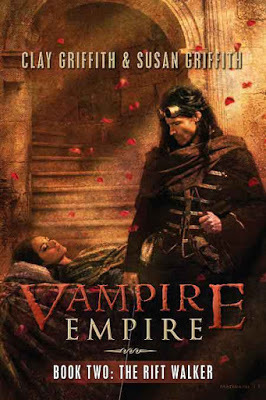
Now add a Princess gone missing in deep vampire territory, and a mysterious masked hero who comes to her aid. Mix both those familiar tropes and add some more: make the princess a very capable Chosen One, and give the masked hero a dark reason to wear that mask. Season this already well-traversed blend with the princess's arrogant fiancée, a blustering war hero from America who we love to hate, a vampire court filled with the intrigue we've all come to assume vampires excel at (just consider the vampires of the Parasol Protectorate series), and a secret cabal of magicians seeking to save the world, and you have a stirring melange of both traditional vampire (this book has some great, gory vampire fights) and the modern vampire (he's a monster, but still pretty sexy and date-worthy).
While many would likely decry some of these ostensibly derivative moments, I think these familiar conventions are used as shorthand, not to shortchange; they convey a horizon of expectation that can later be satisfied or subverted. In some cases, the convention works toward expectations; in others, the convention gives the appearance of familiarity, but with enough surprises that one doesn't anticipate every twist and turn.
To write something even remotely fresh about attractive vampires post-Twilight is a considerable achievement. The Griffiths pull off something very clever in the polemicized fandom of fangs, giving the reader both monstrous and sympathetic vampires. Readers who love paranormal romance with bite who are looking to try some steampunk should check this series out.
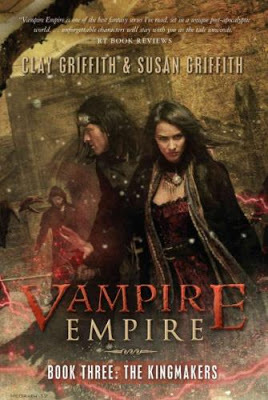 As an afterword, I thoroughly enjoyed The Riftwalker, the sequel to The Greyfriar, but found the conclusion, The Kingmakers, less satisfying. That said, Clay and Susan Griffith's steampunk take on vampires is still worthy of recommendation for its world-building and blending of previous approaches to steampunk secondary worlds. In writing this post and setting up Tweets about it, I've learned that the Griffiths have recently returned to the world of Vampire Empire with The Geomancer
,
hot of the presses later this week!
As an afterword, I thoroughly enjoyed The Riftwalker, the sequel to The Greyfriar, but found the conclusion, The Kingmakers, less satisfying. That said, Clay and Susan Griffith's steampunk take on vampires is still worthy of recommendation for its world-building and blending of previous approaches to steampunk secondary worlds. In writing this post and setting up Tweets about it, I've learned that the Griffiths have recently returned to the world of Vampire Empire with The Geomancer
,
hot of the presses later this week! 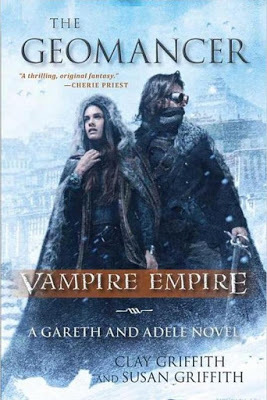
The Greyfriar: Book 1 of the Vampire Empire by Clay & Susan Griffith

I loved The Greyfriar, the first book in Clay and Susan Griffith's Vampire Empire series. I'm getting that out of the way, so the desire to sing its praises won't get in the way of anything else I have to say about it. I'm sad it took me over a year to get to it (and then a few more years to post the review!), but thankful I had the sequel, The Riftwalker, already waiting to be read when I completed The Greyfriar.
I must confess, I judged this book by it's cover, unjustly dismissing it as the worst kind of publishing opportunism, capitalizing on both the popularity of hunky vampires and steampunk back in 2011. I was wrong. To be sure, PYR was marketing this toward a YA audience, even if that isn't the stated intent. The photo manipulated cover by Chris McGrath screams teen gothic paranormal romance with a dash o' steampunk. But when the sequel showed up on my desk, I became intrigued. While quality is certainly no requisite for a sequel in the publishing world, I grew curious as to what had prompted PYR to continue this series.
I was hooked after the first five pages. Take the world of Kim Newman's Anno Dracula, make the vampires the victors, and extrapolate a century into the future. Take that vampire cataclysm and substitute it for the meteor strike in Stirling's Peshawar Lancers, and you have a good idea of the world of the Vampire Empire series: vampires rule the northern hemisphere, and the greatest nations of the world live close to the equator, where longer days provide the protection of sunlight longer.

Now add a Princess gone missing in deep vampire territory, and a mysterious masked hero who comes to her aid. Mix both those familiar tropes and add some more: make the princess a very capable Chosen One, and give the masked hero a dark reason to wear that mask. Season this already well-traversed blend with the princess's arrogant fiancée, a blustering war hero from America who we love to hate, a vampire court filled with the intrigue we've all come to assume vampires excel at (just consider the vampires of the Parasol Protectorate series), and a secret cabal of magicians seeking to save the world, and you have a stirring melange of both traditional vampire (this book has some great, gory vampire fights) and the modern vampire (he's a monster, but still pretty sexy and date-worthy).
While many would likely decry some of these ostensibly derivative moments, I think these familiar conventions are used as shorthand, not to shortchange; they convey a horizon of expectation that can later be satisfied or subverted. In some cases, the convention works toward expectations; in others, the convention gives the appearance of familiarity, but with enough surprises that one doesn't anticipate every twist and turn.
To write something even remotely fresh about attractive vampires post-Twilight is a considerable achievement. The Griffiths pull off something very clever in the polemicized fandom of fangs, giving the reader both monstrous and sympathetic vampires. Readers who love paranormal romance with bite who are looking to try some steampunk should check this series out.
 As an afterword, I thoroughly enjoyed The Riftwalker, the sequel to The Greyfriar, but found the conclusion, The Kingmakers, less satisfying. That said, Clay and Susan Griffith's steampunk take on vampires is still worthy of recommendation for its world-building and blending of previous approaches to steampunk secondary worlds. In writing this post and setting up Tweets about it, I've learned that the Griffiths have recently returned to the world of Vampire Empire with The Geomancer
,
hot of the presses later this week!
As an afterword, I thoroughly enjoyed The Riftwalker, the sequel to The Greyfriar, but found the conclusion, The Kingmakers, less satisfying. That said, Clay and Susan Griffith's steampunk take on vampires is still worthy of recommendation for its world-building and blending of previous approaches to steampunk secondary worlds. In writing this post and setting up Tweets about it, I've learned that the Griffiths have recently returned to the world of Vampire Empire with The Geomancer
,
hot of the presses later this week! 
Mike Perschon's Blog
- Mike Perschon's profile
- 3 followers



